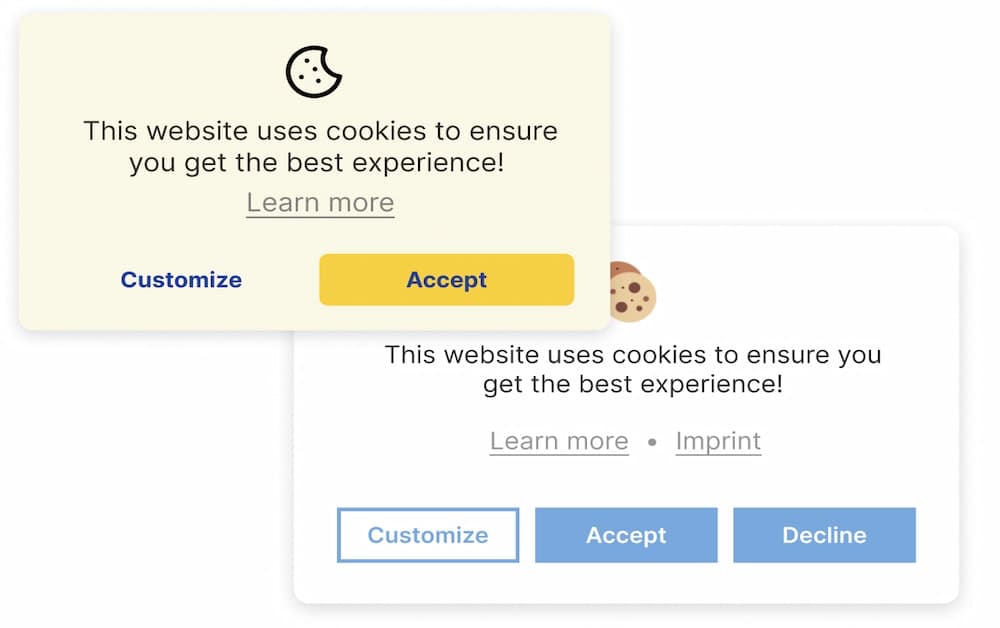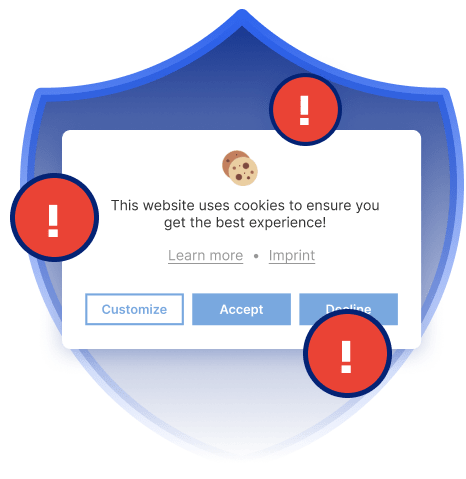Introduction
The General Data Protection Regulation (GDPR) and the ePrivacy Directive, commonly known as the “cookie law,” represent essential legal frameworks aimed at safeguarding user privacy and fostering transparency regarding the collection and processing of personal data on the Internet. These privacy laws necessitate clear and affirmative consent, ensuring compliance and avoiding practices like pre-ticked boxes. This comprehensive report delves into a thorough examination of eight specific issues identified within the cookie consent mechanisms present on a range of websites. Additionally, our analysis encompasses a detailed legal evaluation of these identified concerns, followed by a set of recommendations tailored to assist in achieving compliance with the pertinent regulations.
Issue 1: No reject button on the first layer
Problem: One of the primary issues identified is the absence of a “Reject” button on the first layer of the cookie consent banner. Users are often presented with an option to “Accept All” cookies immediately. Still, the option to refuse non-essential cookies is either buried in a secondary layer or not provided at all. This practice can lead to a significant imbalance in user choice, coercing users into accepting cookies by making rejection more cumbersome. Additionally, cookie banners should be designed with less prominent styles and simpler text link buttons to enhance user experience and compliance. Users often face the same issue when trying to revert new button styles to simpler text links.
Legal analysis: According to GDPR guidelines, consent must be freely given, specific, informed, and unambiguous. By not providing a clear and accessible option to reject cookies on the first layer, these practices violate the requirement for consent to be as easy to withdraw as it is to give. The Article 29 Working Party (now the European Data Protection Board) has emphasized that users should not be manipulated into giving consent. Data protection authorities also stress the importance of providing a ‘Reject’ option to ensure compliance and avoid potential fines.
Recommendation: Websites must include a “Reject All” button on the first layer of their cookie consent banner, placed with equal prominence as the “Accept All” button. This ensures that users can easily refuse consent without unnecessary obstacles.
Issue 2: Pre-ticked boxes
Problem: Another common issue is the use of pre-ticked boxes for cookie categories beyond the strictly necessary ones. Users are required to manually deselect these boxes if they do not wish to consent to the use of these cookies. This practice can lead to unintentional consent, as users may overlook the pre-selected options.
Legal analysis: Under the GDPR, proper consent must be an affirmative action on the part of the user, meaning that pre-ticked boxes do not constitute valid consent. The Court of Justice of the European Union (CJEU) ruled in the Planet49 case that pre-ticked boxes are not a valid means of obtaining consent under EU law.
Recommendation: All cookie categories except those that are strictly necessary should be presented with unticked boxes by default. Users should actively select their preferences to provide valid consent.
Issue 3: Deceptive link design
Problem: Many cookie consent banners utilize deceptive link designs, where the link to manage cookie preferences is either minimized or hidden behind vague wording such as “More Options” or “Learn More.” These links are often less prominent and more difficult to find compared to the “Accept All” button. This can lead to frustration among website visitors, who expect clear and accessible cookie management options.
Legal analysis: Deceptive design practices undermine the requirement for informed consent under the GDPR. Users must be made fully aware of their options in a clear and straightforward manner. Hiding essential options like cookie management behind ambiguous links does not meet the standard for informed consent.
Recommendation: Websites should ensure that links to cookie settings or preferences are clearly labeled and as prominently displayed as any other option. Phrasing should be explicit, such as “Manage Cookie Preferences” or “Reject Non-Essential Cookies.”

Issue 4: Deceptive button colors
Problem: The use of color psychology is another tactic employed by some websites to nudge users into accepting cookies. For instance, the “Accept All” button might be highlighted in a bold, bright color, while the “Manage Settings” or “Reject” button is presented in a less noticeable color, such as grey. This visual hierarchy can mislead users into believing that accepting cookies is the preferred or only choice.
Legal analysis: The GDPR requires that consent be freely given. Using design elements like button color to influence user decisions can be considered a form of coercion, which contravenes the principle of freely given consent. The European Data Protection Board (EDPB) has indicated that any design that skews user choice can invalidate consent. Additionally, deceptive button colors can undermine data privacy by compromising user consent, especially in jurisdictions with strict regulations like the EU.
Recommendation: All choices in a cookie consent banner should be presented in a neutral manner. Buttons should use consistent colors and visual prominence to ensure that no option is inadvertently favored over another.
Issue 5: Deceptive button contrast
Problem: Similar to deceptive button colors, some websites use varying levels of contrast to differentiate between the “Accept All” and “Reject” or “Manage Settings” buttons. The “Accept All” button might be given a high-contrast design, making it stand out, while the “Reject” button is designed with low contrast, making it blend into the background.
Legal analysis: This practice is a violation of the GDPR’s requirement for transparency and freely given consent. By making the “Reject” button less visible, websites are effectively pressuring users into accepting cookies, which undermines the legitimacy of the consent obtained. This deceptive practice also raises significant concerns regarding data privacy, as it compromises the user’s ability to manage their consent and privacy settings effectively.
Recommendation: Websites should ensure that all buttons within the cookie consent interface have equal contrast and visibility. Users should not be visually steered toward one option over another.
Issue 6: Legitimate interest claimed
Problem: Some websites claim legitimate interest as the legal basis for processing personal data without obtaining explicit consent. This is often done without providing clear information on what constitutes this legitimate interest and how it is balanced against the user’s rights and freedoms.
Legal analysis: While GDPR allows for processing based on legitimate interest, this basis must be used sparingly and with full transparency. Websites must conduct a Legitimate Interests Assessment (LIA) to ensure that their interests do not override the rights of users. Moreover, users must be informed about this assessment and have the right to object to processing based on legitimate interest. A task force often evaluates compliance with these legitimate interest claims, ensuring that practices align with established privacy laws.
Recommendation: Websites should provide detailed explanations of their legitimate interests and the assessments they have conducted. Additionally, users should be given clear options to object to such processing.

Issue 7: Inaccurately classified cookies
Problem: Websites often inaccurately classify cookies, labeling cookies that track user behavior as “necessary” or “functional,” even when they serve marketing or analytics purposes. This misclassification can lead users to consent to more invasive tracking without fully understanding what they are agreeing to. For instance, cookies used by Google Analytics must be accurately classified to ensure compliance with privacy regulations.
Legal analysis: Misclassification of cookies violates the principle of transparency under the GDPR. Users must be accurately informed about the purpose of each cookie and given the option to consent or refuse based on clear and truthful information.
Recommendation: Websites should conduct thorough audits of their cookie use and ensure that each cookie is accurately classified according to its true purpose. Cookie consent banners should clearly delineate between strictly necessary cookies and those used for analytics, marketing, or other non-essential purposes.
Issue 8: Not as easy to withdraw as to give consent
Problem: Withdrawing consent is often more complex than giving it. Some websites make the process of revoking consent difficult by requiring users to navigate through multiple layers of settings or contact customer service. In contrast, giving consent is usually a one-click process.
Legal analysis: The GDPR mandates that withdrawing consent should be as easy as giving it. Any hurdles placed in the way of consent withdrawal are in violation of this requirement and can lead to penalties for non-compliance. Data protection authorities emphasize that users must have clear options to reject or deny cookie usage, and failing to provide such options can result in fines.
Recommendation: Websites should implement a simple and direct method for users to withdraw consent, such as a clearly visible “Withdraw Consent” button on the main page or within the cookie banner itself. The process should be straightforward and require no more steps than the process of giving consent.

Ensuring Shopify store compliance with the Pandectes GDPR Compliance App
For Shopify store owners, maintaining compliance with regulations like the GDPR (General Data Protection Regulation) and CCPA (California Consumer Privacy Act) can be challenging, especially when it comes to managing cookie banners and ensuring that all legal requirements are met. The Pandectes GDPR Compliance App is designed to simplify this process, providing a comprehensive solution that addresses the complexities of cookie consent and data protection in an efficient and user-friendly manner. Additionally, the app helps manage data privacy by offering robust settings to handle user consent and privacy preferences, particularly for visitors in jurisdictions with strict regulations like the EU.
Key features of the Pandectes GDPR Compliance App
The Pandectes GDPR Compliance App offers a wide range of features specifically tailored to help Shopify stores meet the stringent requirements of GDPR and CCPA, including customizable cookie banners. Here’s how the app takes care of the heavy lifting when it comes to consent banner issues and data privacy management:
Customizable consent banners:
The app provides fully customizable consent banners that can be tailored to match the look and feel of your store. These banners are designed to meet the strict requirements of GDPR, ensuring that users can easily give or refuse consent with clear, prominent options. The ability to customize the CSS of the cookie banner is greatly appreciated by users.
Unlike many generic solutions, Pandectes allows you to include both “Accept All” and “Reject All” buttons on the first layer of the banner. This feature ensures compliance by making it just as easy for users to refuse cookies as it is to accept them, addressing a key issue in GDPR compliance.
Automatic cookie classification:
One of the most challenging aspects of GDPR compliance is accurately classifying cookies and ensuring that users are informed about what each type of cookie does. The Pandectes app automatically detects and classifies cookies used on your site, categorizing them as necessary, functional, analytics, or marketing.
This automation helps prevent issues like inaccurately classified cookies, which can lead to non-compliance. By ensuring that each cookie is correctly labeled, the app provides transparency and helps you maintain the trust of your customers.
Consent management and record keeping:
Pandectes not only facilitates the collection of consent but also manages and stores user consent records. This feature is essential for demonstrating compliance during audits, as GDPR requires that you be able to prove that consent was obtained legally.
The app also supports consent withdrawal, allowing users to easily change their preferences or withdraw consent at any time. This feature is critical for meeting the GDPR’s requirement that withdrawing consent should be as easy as giving it.
Legitimate interest handling:
If your store processes data based on legitimate interest rather than explicit consent, the Pandectes app provides tools to ensure compliance. It allows you to clearly communicate legitimate interests to users and gives them the option to object, as required by GDPR.
This feature helps address the challenge of balancing business needs with user rights, ensuring that your store remains compliant while pursuing legitimate interests.
Compliance with multiple regulations:
While the app is focused on GDPR compliance, it also supports compliance with other regulations like the CCPA. This multi-regulatory support is particularly beneficial for stores that operate in multiple jurisdictions, allowing them to manage all their privacy obligations from a single platform.
The app’s flexibility means that it can be configured to meet the specific requirements of different laws, ensuring that your store remains compliant no matter where your customers are located.
User-friendly interface and easy integration:
Pandectes is designed with ease of use in mind. The app integrates seamlessly with Shopify, requiring minimal setup and technical expertise. Its user-friendly interface allows you to manage your compliance settings effortlessly without needing to delve into complex legal jargon.
For store owners who are not well-versed in data protection laws, this simplicity is a significant advantage, as it reduces the risk of non-compliance due to misunderstanding or oversight.
Conclusion
In order to achieve compliance with GDPR, the ePrivacy Directive, and various privacy laws, it is essential to address the following eight key issues related to cookie consent mechanisms. By implementing transparent, user-friendly consent practices and regularly reviewing your cookie policies, you can enhance transparency, build user trust, and ensure adherence to regulatory standards. This involves clearly communicating to users how their data will be used, providing easily accessible consent options, obtaining explicit consent for specific types of data processing, allowing users to easily withdraw consent, providing granular consent options, ensuring that consent is freely given and not bundled with other terms and conditions, keeping records of consents obtained, and considering the age of users when obtaining consent. By addressing these issues, you can demonstrate a commitment to safeguarding user privacy and meeting legal requirements.




